Too Much of a Good Thing? The Impact of Government Subsidies on Incubator Services: Empirical Evidence from China
Abstract
1. Introduction
2. Literature Review and Research Hypotheses
2.1. Literature Review
2.1.1. Motivation and Effectiveness of Government Subsidies
2.1.2. Classification of Incubation Services
2.1.3. Government Subsidies and Incubator Development
2.2. Research Hypotheses
3. Research Methodology
3.1. GPSM
3.2. Accounting and Definition of Variables
- Treatment of variables.
- 2.
- Outcome variables.
- 3.
- Covariates.
4. Empirical Results and Analysis
4.1. Sources of Data and Descriptive Statistical Analysis
4.2. Baseline Regressions
4.3. Selective Bias Problem–GPSM
4.3.1. Fractional Logit Regression of Subsidy Intensity
4.3.2. Results of the “Dose-Response” Function
4.4. Robustness and Time Trend
5. Conclusions and Insights
5.1. Conclusions
5.2. Policy Insights
- (1)
- Capturing the right amount of subsidy policy intensity. This paper, after overcoming selectivity bias, arrives at an inverted U-shaped relationship between the intensity of government subsidies and incubation services. The government should not be blind in its subsidies; it is not always the case that more generous input will result in higher performance. The key is to grasp the intensity of the policy to achieve the ‘win–win’ goal of improving performance and optimizing incubation services. From the findings of the full sample in this paper, it is generally appropriate for government subsidies to account for less than 30% of incubator revenues.
- (2)
- Improving the regulatory mechanism after government subsidies. From the results of this paper, it appears that the range of subsidies that have a marginal positive impact on the basic services of the space is much smaller than that of value-added services and investment services. However, in reality, most incubators tend to pursue short-term benefits after receiving government subsidies and thus blindly expand the scope of their space. The government should assess the amount of subsidies given to incubators on a regular basis to avoid incubators being reduced to “second home owners” in the market, resulting in a waste of government resources.
- (3)
- Enriching incubator industry support policies. From a time-dimensional point of view, the moderate range of marginal positive impacts of government subsidies on incubation services is gradually shrinking, which may also be a signal to remind the government of the need to adjust its industrial support policies for the incubator industry. In addition to short, fast, and direct government subsidies, there are various forms of industrial support. Compared to government subsidies–which have many communication costs, running costs, supervision costs, and even the challenge of corruption and other problems in the process, from planning, implementation, evaluation to supervision–a universal tax incentive policy can reduce these unnecessary losses. The government should flexibly combine different industrial policies based on different policy features to achieve 1 + 1 > 2 policy effects. In the future, it would be a better option for the government to set up incubation funds to support incubators and start-ups.
5.3. Limitations
Author Contributions
Funding
Institutional Review Board Statement
Informed Consent Statement
Data Availability Statement
Conflicts of Interest
Appendix A


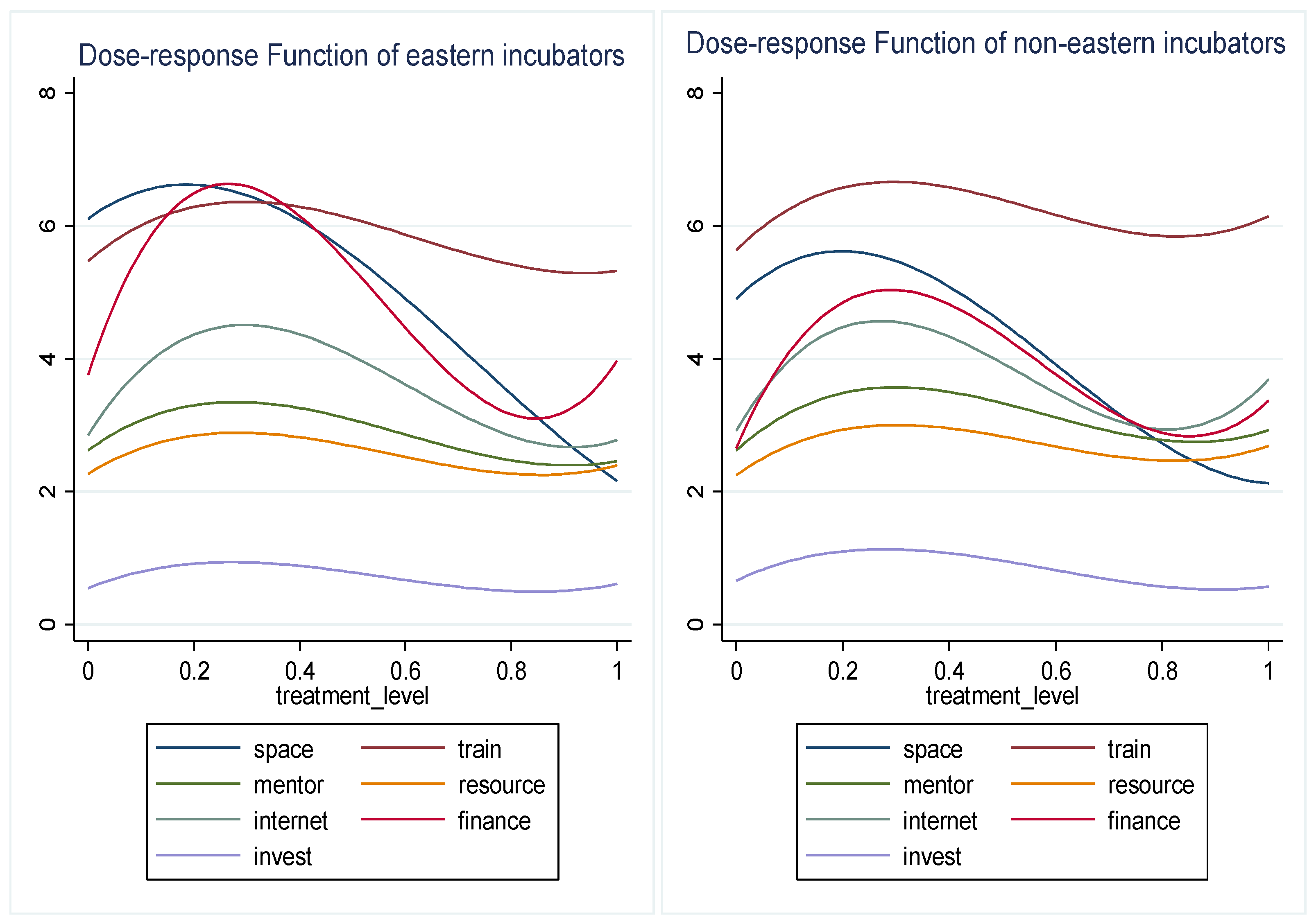
Appendix B
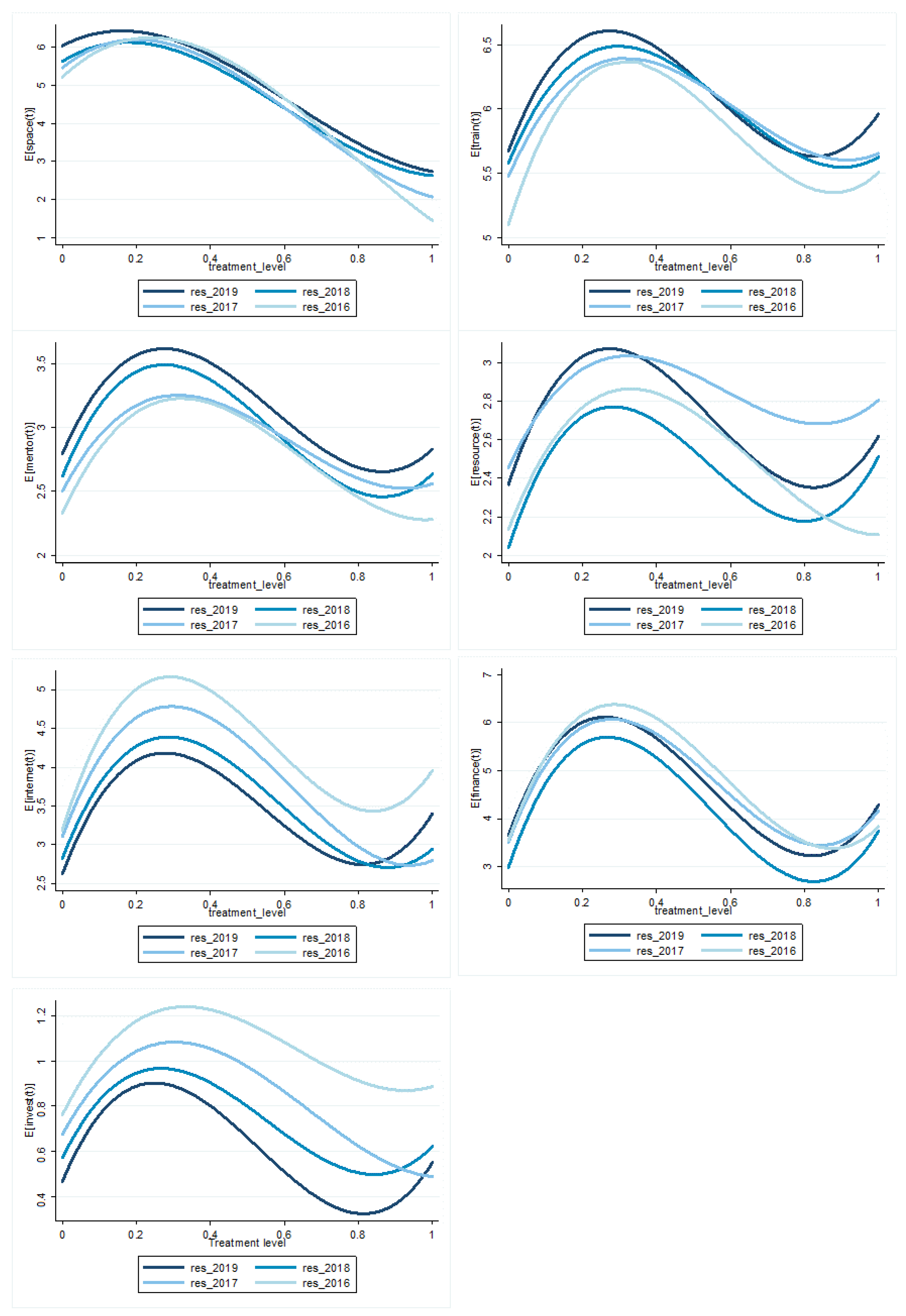
References
- Avnimelech, G.; Schwartz, D.; Bar-El, R. Entrepreneurial high-tech cluster development: Israel’s experience with venture capital and technological incubators. Eur. Plan Stud. 2007, 15, 1181–1198. [Google Scholar] [CrossRef]
- Frenkel, A.; Shefer, D.; Miller, M. Public versus private technological incubator programmes: Privatizing the technological incubators in Israel. Eur. Plan Stud. 2008, 16, 189–210. [Google Scholar] [CrossRef]
- Avnimelech, G.; Teubal, M. Creating venture capital industries that co-evolve with high tech: Insights from an extended industry life cycle perspective of the Israeli experience. Res. Policy 2006, 35, 1477–1498. [Google Scholar] [CrossRef]
- Ndabeni, L.L. The contribution of business incubators and technology stations to small enterprise development in South Africa. Dev. South. Afr. 2008, 25, 259–268. [Google Scholar] [CrossRef]
- Mothibi, G. The Influence of Business Incubation Services on the Performance of Small Medium Enterprises in the South African Tourism Industry. In 10th European Conference on Management Leadership and Governance (ECMLG); Academic Conferences International Limited: Reading, UK, 2014; pp. 569–576. [Google Scholar]
- Wang, H.; Lin, D.; Yin, H.; Lu, Q.; Cheng, H. IEEE Linking Incubator Services to the Performance of Incubated Firms: A Review. In IEEE International Conference on Management of Innovation and Technology; IEEE: New York, NY, USA, 2008; p. 894. [Google Scholar]
- Zhang, G.; Guan, R.; Wang, H. The Nonlinear Causal Relationship Between Environmental Regulation and Technological Innovation-Evidence Based on the Generalized Propensity Score Matching Method. Sustainability 2020, 12, 352. [Google Scholar] [CrossRef]
- Aydin, U. Promoting industries in the global economy: Subsidies in OECD countries, 1989 to 1995. J. Eur. Public Policy 2007, 14, 115–131. [Google Scholar] [CrossRef]
- Zhang, Y.; Han, Q. Development of electric vehicles for China’s power generation portfolio: A regional economic and environmental analysis. J. Clean Prod. 2017, 162, 71–85. [Google Scholar] [CrossRef]
- Myojo, S.; Ohashi, H. Effects of consumer subsidies for renewable energy on industry growth and social welfare: The case of solar photovoltaic systems in Japan. J. Jpn. Int. Econ. 2018, 48, 55–67. [Google Scholar] [CrossRef]
- Buravleva, Y.; Tang, D.; Bethel, B.J. Incentivizing Innovation: The Causal Role of Government Subsidies on Lithium-Ion Battery Research and Development. Sustainability 2021, 13, 8309. [Google Scholar] [CrossRef]
- Wittman, D. Competitive governments: An economic theory of politics and public finance. South. Econ. J. 1998, 64, 1011–1012. [Google Scholar] [CrossRef]
- Cerqua, A.; Pellegrini, G. Do subsidies to private capital boost firms’ growth? A multiple regression discontinuity design approach. J. Public Econ. 2014, 109, 114–126. [Google Scholar] [CrossRef]
- Tang, Q.; Luo, D. An Empirical Study on the Motivation and Effect of Government Subsidy. Financ. Stud. 2007, 6, 149–163. [Google Scholar]
- Becker, B. Public R&D policies and private R&D investment: A survey of the empirical evidence. J. Econ. Surv. 2015, 29, 917–942. [Google Scholar]
- Silva, F.; Carreira, C. Do financial constraints threat the innovation process? Evidence from Portuguese firms. Econ. Innov. New Technol. 2012, 21, 701–736. [Google Scholar] [CrossRef]
- Hou, P.; Zhou, M.; Xu, J.; Liu, Y. Financialization, Government Subsidies, and Manufacturing R&D Investment: Evidence from Listed Companies in China. Sustainability 2021, 13, 12633. [Google Scholar]
- Zhan, J.; Shao, X.; Xu, M. Influence of government subsidies on agricultural firms R&D investment. Sci. Res. Manag. 2019, 40, 103–111. [Google Scholar]
- Hu, J.; Huang, Q.; Pan, X. Environmental Regulation, Government Subsidies and Innovation Quality: Quasi-Natural Experiment Based on China’s Carbon Emissions Trading Pilot. Sci. Sci. Manag. S. T. 2020, 41, 50–65. [Google Scholar]
- Wu, J.; Shang, J. Green Credit Financing Equilibrium under Government Subsidy and Supply Uncertainty. Sustainability 2021, 13, 12917. [Google Scholar] [CrossRef]
- Jia, L.; Nam, E.; Chun, D. Impact of Chinese government subsidies on enterprise innovation: Based on a three-dimensional perspective. Sustainability 2021, 13, 1288. [Google Scholar] [CrossRef]
- Zuniga-Vicente, J.A.; Alonso-Borrego, C.; Forcadell, F.J.; Galan, J.I. Aassessing the effect of public subsidies on firm R&D investment: A survey. J. Econ. Surv. 2014, 28, 36–67. [Google Scholar]
- Boldrin, M.; Levine, D.K. Rent-seeking and innovation. J. Monet. Econ. 2004, 51, 127–160. [Google Scholar] [CrossRef]
- Tzelepis, D.; Skuras, D. The effects of regional capital subsidies on firm performance: An empirical study. J. Small Bus. Enterp. Dev. 2004, 11, 121–129. [Google Scholar] [CrossRef]
- Gao, W.; Wang, D. Will Increasing Government Subsidies Promote Open Innovation? A Simulation Analysis of China’s Wind Power Industry. Sustainability 2021, 13, 13497. [Google Scholar] [CrossRef]
- Bergek, A.; Norrman, C. Incubator best practice: A framework. Technovation 2008, 28, 20–28. [Google Scholar] [CrossRef]
- Rice, M.P. Co-production of business assistance in business incubators—An exploratory study. J. Bus Ventur. 2002, 17, 163–187. [Google Scholar] [CrossRef]
- Bollingtoft, A.; Ulhoi, J.P. The networked business incubator—Leveraging entrepreneurial agency? J. Bus Ventur. 2005, 20, 265–290. [Google Scholar] [CrossRef]
- Sung, T.K.; Gibson, D.V.; Kang, B.S. Characteristics of technology transfer in business ventures: The case of Daejeon, Korea. Technol Forecast. Soc. 2003, 70, 449–466. [Google Scholar] [CrossRef][Green Version]
- Pauwels, C.; Clarysse, B.; Wright, M.; Van Hove, J.U. Understanding a new generation incubation model: The accelerator. Technovation 2016, 50–51, 13–24. [Google Scholar] [CrossRef]
- Adegbite, O. Business incubators and small enterprise development: The Nigerian experience. Small Bus. Econ. 2001, 17, 157–166. [Google Scholar] [CrossRef]
- Santos, D. Building entrepreneurial ecosystems: The case of Coimbra. J. Sci. Technol. Policy Manag. 2022, 13, 73–89. [Google Scholar] [CrossRef]
- Bruneel, J.; Ratinho, T.; Clarysse, B.; Groen, A. The Evolution of Business Incubators: Comparing demand and supply of business incubation services across different incubator generations. Technovation 2012, 32, 110–121. [Google Scholar] [CrossRef]
- Tang, M.F.; Lee, J.; Liu, K.; Lu, Y. Assessing government-supported technology-based business incubators: Evidence from China. Int. J. Technol. Manag. 2014, 65, 24–48. [Google Scholar] [CrossRef]
- Dierickx, I.; Cool, K. Asset Stock Accumulation And The Sustainability of Competitive Advantage—Reply. Manag. Sci. 1989, 35, 1514. [Google Scholar] [CrossRef]
- Jourdan, J.; Kivleniece, I. Too much of a good thing? The dual effect of public sponsorship on organizational performance. Acad. Manag. J. 2017, 60, 55–77. [Google Scholar] [CrossRef]
- Xu, Z.; Cai, E.; Chen, C. Does Incubation Subsidies Improve Incubation Services?: Empirical Study on Incubator Data of Guangdong Province. Sci. Sci. Manag. S. T. 2021, 42, 20–31. [Google Scholar]
- Feldman, M.P.; Kelley, M.R. The ex-ante assessment of knowledge spillovers: Government R&D policy, economic incentives and private firm behavior. Res. Policy 2006, 35, 1509–1521. [Google Scholar]
- Alchian, A.A.; Demsetz, H. Production, Information Costs, And Economic Organization. Am. Econ. Rev. 1972, 62, 777–795. [Google Scholar]
- Boardman, A.E.; Vining, A.R. Ownership and performance in competitive environments—A comparison of the performance of private, mixed, and state-owned enterprises. J. Law Econ. 1989, 32, 1–33. [Google Scholar] [CrossRef]
- Williamson, O.E. Public and private bureaucracies: A transaction cost economics perspective. J. Law Econ. Organ. 1999, 15, 306–342. [Google Scholar] [CrossRef]
- Ramaswamy, K.; Li, M.F.; Veliyath, R. Variations in ownership behavior and propensity to diversify: A study of the Indian corporate context. Strateg. Manag. J. 2002, 23, 345–358. [Google Scholar] [CrossRef]
- Shleifer, A. State versus private ownership. J. Econ. Perspect. 1998, 12, 133–150. [Google Scholar] [CrossRef]
- Restuccia, D.; Rogerson, R. Policy distortions and aggregate productivity with heterogeneous establishments. Rev. Econ. Dynam. 2008, 11, 707–720. [Google Scholar] [CrossRef]
- Rosenbaum, P.R.; Rubin, D.B. The central role of the propensity score in observational studies for causal effects. Biometrika 1983, 70, 41–55. [Google Scholar] [CrossRef]
- Imbens, G.W. The role of the propensity score in estimating dose-response functions. Biometrika 2000, 87, 706–710. [Google Scholar] [CrossRef]
- Hirano, K.; Imbens, G.W. The Propensity Score with Continuous Treatments. In Applied Bayesian Modelling and Causal Inference from Incomplete-Data Perspectives; Wiley Online Librar: New York, NY, USA, 2004; pp. 73–84. [Google Scholar]
- Papke, L.E.; Wooldridge, J.M. Econometric Methods for Fractional Response Variables with an Application to 401(k) Plan Participation Rates; National Bureau of Economic Research, Inc.: Cambridge, MA, USA, 1993. [Google Scholar]
- McCullagh, P.; Nelder, J.A. Generalized Linear Model; Chapman & Hall/CRC: New York, NY, USA, 1989. [Google Scholar]
- Kang, Z.; Zhang, Y.; Tang, X.; Liu, X. Does the Policy of “Reducing Carbon” Restrict the Export of Chinese Enterprises. China Ind. Econ. 2018, 9, 117–135. [Google Scholar]

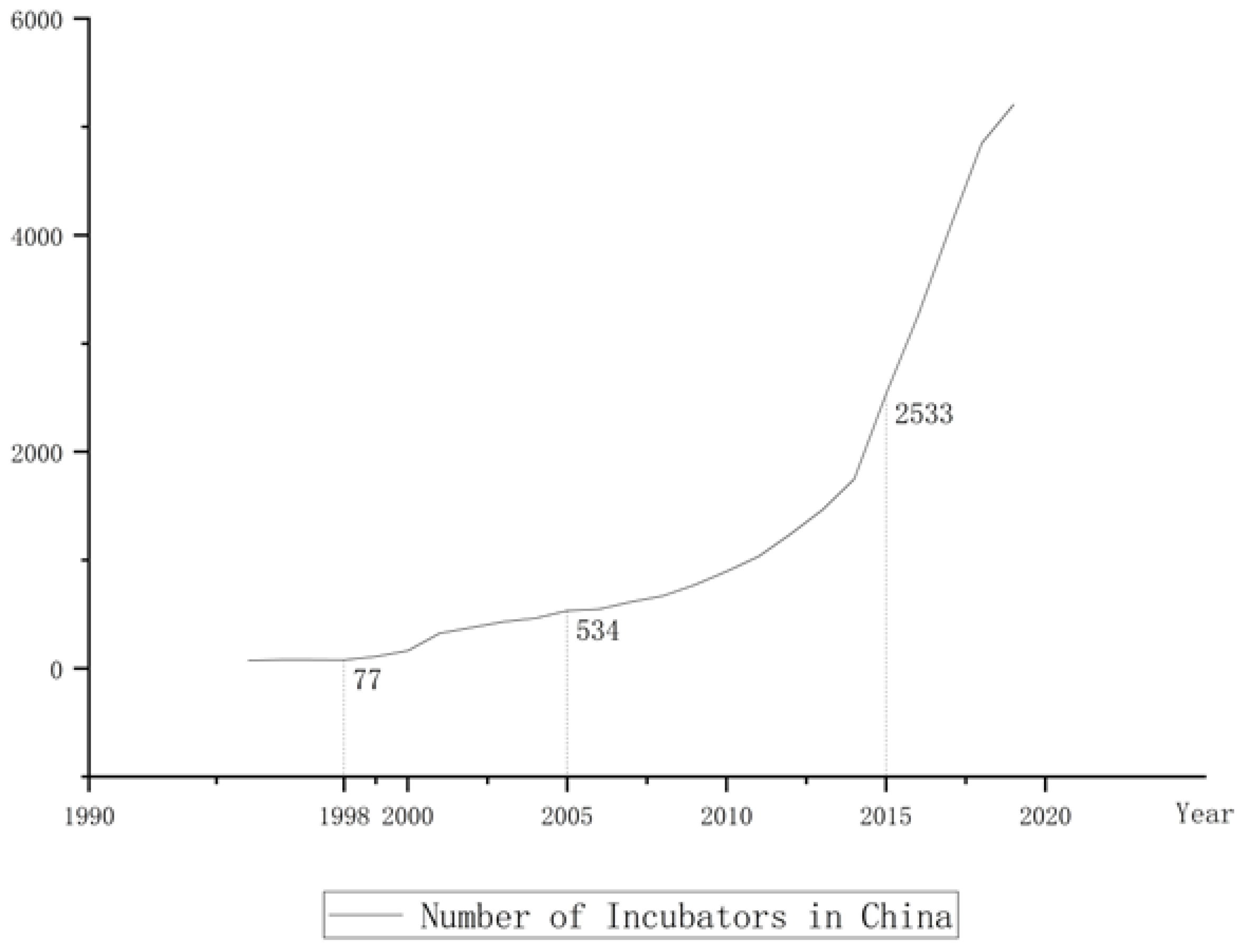
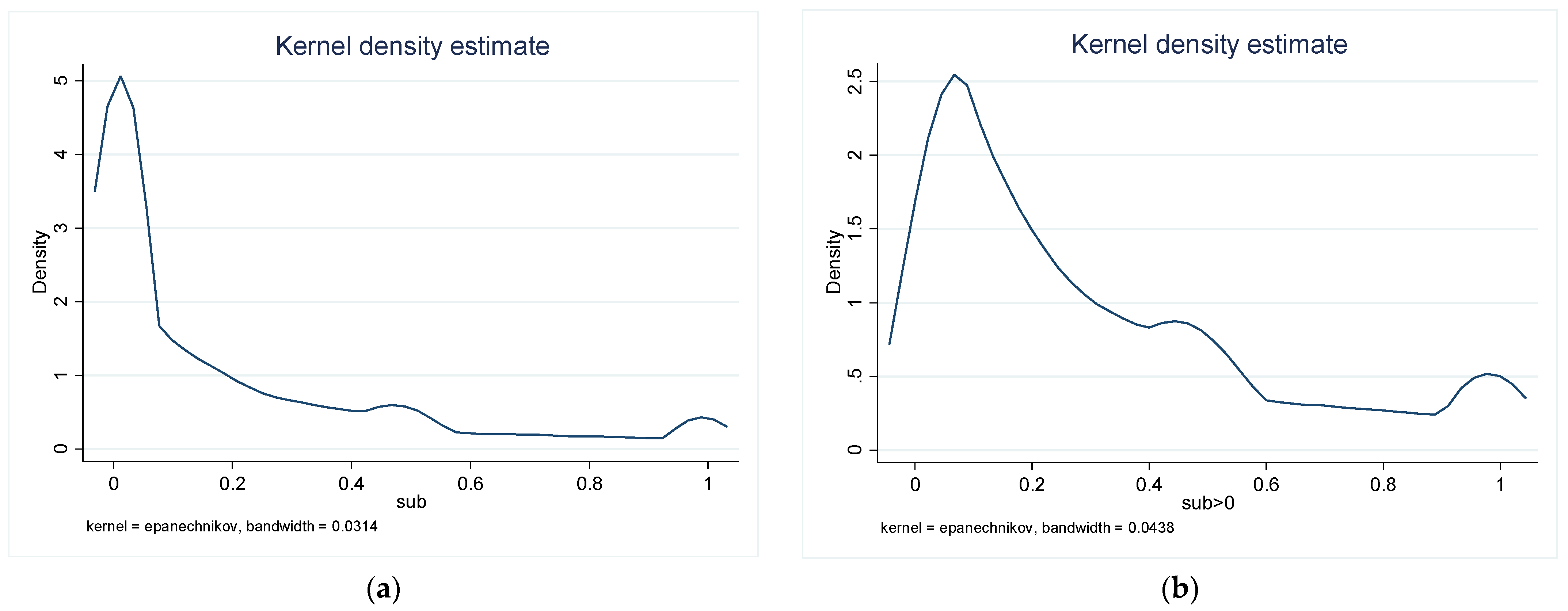


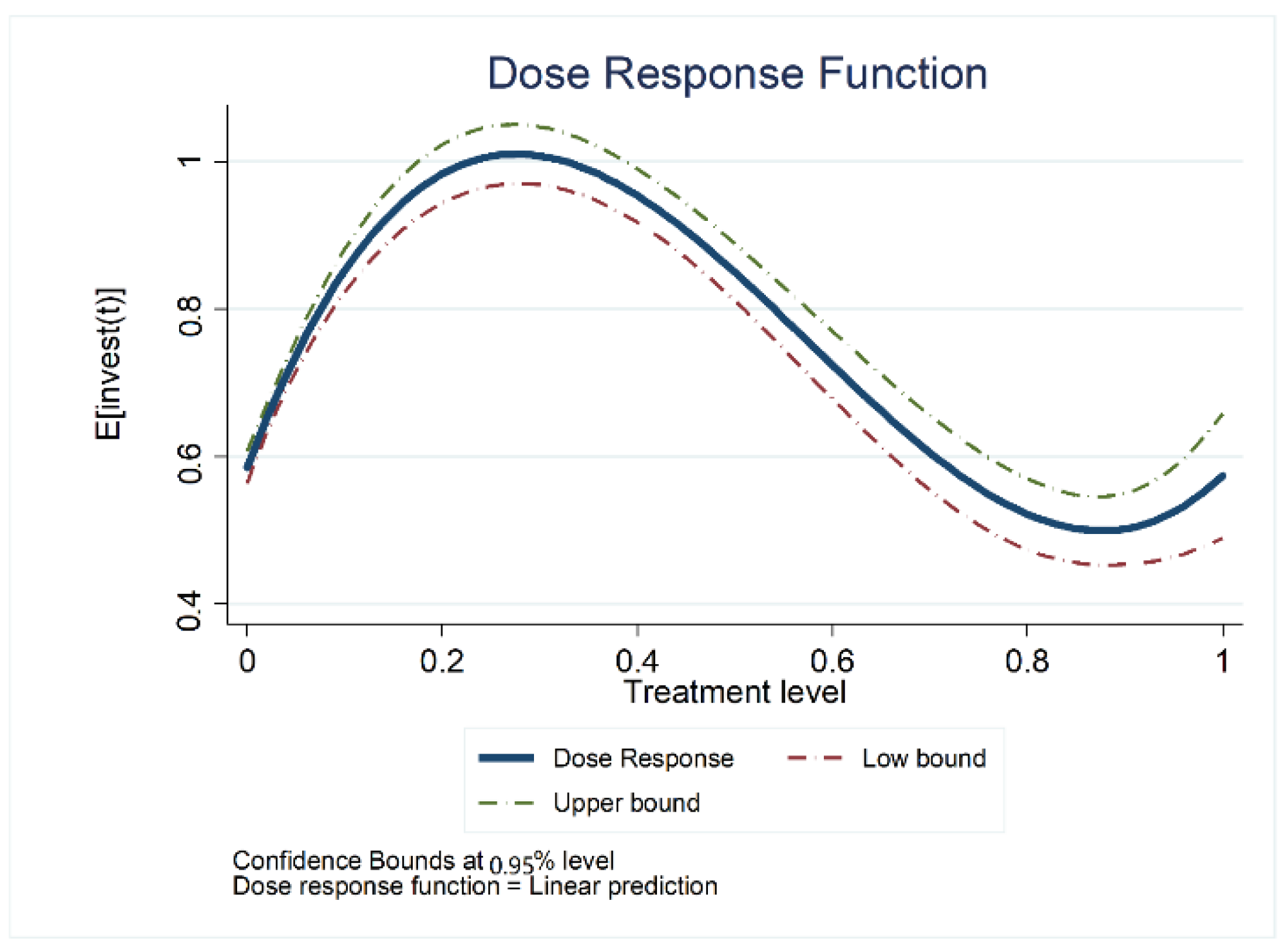
| Category | Variable Name | Symbol | Unit | Specific Explanation | |
|---|---|---|---|---|---|
| Treatment variable | Subsidy intensity | Sub | / | The amount of government subsidy divided by the total revenue of the incubator | |
| Result variables | Space infrastructure services | space | Thousand yuan | Log of space and property management revenue | |
| Value-added services | Training services | Train | / | Log of the number of incubatees trained (For numbers of 0, +1 takes the logarithm, the same below.) | |
| Business coaching Services | mentor | / | Log of the number of business mentors to companies | ||
| Resource link service | resource | / | Log of the number of innovative and entrepreneurial activities | ||
| Network service | internet | Thousand yuan | Log of the investment amount of public technology service platform | ||
| Financing intermediary services | finance | Thousand yuan | Log of the amount of financing received by the incubatees in the current year | ||
| Investment services | invest | / | Log of the number of companies invested by the incubation fund | ||
| Covariates | The administrative level | level | / | If it is national level, the value is 1 otherwise it is 0 | |
| Nature | national | / | If it is a state-owned incubator, take the value of 1; otherwise, it is 0 | ||
| Whether it receives financial investment | gov_invest | / | If there is financial investment, take the value of 1; otherwise, it is 0 | ||
| Total revenue | revenue | Thousand yuan | Log of the total revenue of the incubator | ||
| Year of establishment | Age | Year | Log of the incubator’s establishment | ||
| Variable | Full Samples | Mean of Sub > 0 Samples | ||||||
|---|---|---|---|---|---|---|---|---|
| Mean | Std. Dev | Min | Max | (0,0.026] | (0.026,0.236] | (0.236,0.507] | (0.507,1] | |
| Sub | 0.167 | 0.253 | 0 | 1 | 0.002 | 0.112 | 0.371 | 0.793 |
| Base | 0.500 | 0.374 | 0 | 1 | 0.522 | 0.546 | 0.430 | 0.389 |
| Train | 5.993 | 1.561 | 0 | 10 | 5.632 | 6.437 | 6.320 | 5.985 |
| Mentor | 3.071 | 1.240 | 0 | 7.124 | 2.754 | 3.479 | 3.346 | 3.038 |
| Resource | 2.600 | 1.047 | 0 | 6.458 | 2.344 | 2.917 | 2.841 | 2.575 |
| Internet | 3.167 | 3.167 | 0 | 12.015 | 2.466 | 4.147 | 3.551 | 3.210 |
| Finance | 3.868 | 4.374 | 0 | 13.908 | 2.857 | 5.381 | 4.525 | 3.498 |
| Invest | 0.602 | 0.875 | 0 | 5.283 | 0.440 | 0.843 | 0.733 | 0.514 |
| Level | 0.247 | 0.431 | 0 | 1 | 0.156 | 0.377 | 0.314 | 0.214 |
| National | 0.187 | 0.390 | 0 | 1 | 0.156 | 0.231 | 0.194 | 0.206 |
| Gov_invest | 0.356 | 0.479 | 0 | 1 | 0.273 | 0.341 | 0.500 | 0.577 |
| Revenue | 7.509 | 2.420 | 0 | 14.068 | 7.593 | 8.445 | 7.214 | 4.969 |
| Age | 1.775 | 0.723 | 0 | 4.248 | 1.720 | 1.918 | 1.791 | 1.628 |
| Variable | Space | Train | Mentor | Resource | Internet | Finance | Invest |
|---|---|---|---|---|---|---|---|
| Sub | −0.664 ** | 1.947 *** | 1.792 *** | 1.674 *** | 3.311 *** | 4.015 *** | 0.910 *** |
| (0.404) | (0.199) | (0.153) | (0.137) | (0.448) | (0.518) | (0.122) | |
| Sub squared | −1.695 *** | −1.624 *** | −1.682 *** | −1.557 *** | −2.980 *** | −3.311 *** | −0.904 *** |
| (0.459) | (0.240) | (0.182) | (0.166) | (0.522) | (0.606) | (0.143) | |
| Level | 0.717 *** | 1.186 *** | 1.275 *** | 0.672 *** | 2.298 *** | 4.134 *** | 0.597 *** |
| (0.092) | (0.045) | (0.037) | (0.032) | (0.105) | (0.122) | (0.028) | |
| National | 0.254 *** | −0.011 | −0.014 | −0.004 | −0.022 | 0.395 *** | −0.161 *** |
| (0.083) | (0.041) | (0.033) | (0.029) | (0.094) | (0.105) | (0.025) | |
| Gov_invest | −0.380 *** | 0.046 | −0.130 *** | −0.077 *** | 0.203 *** | −0.061 | 0.116 *** |
| (0.081) | (0.040) | (0.031) | (0.028) | (0.087) | (0.010) | (0.025) | |
| Revenue | 0.456 *** | 0.087 *** | 0.055 *** | 0.052 *** | 0.199 *** | 0.202 *** | 0.040 *** |
| (0.018) | (0.009) | (0.007) | (0.006) | (0.018) | (0.022) | (0.005) | |
| Age | 0.177 *** | −0.139 *** | −0.158 *** | −0.168 *** | −0.002 | −0.119 *** | −0.053 *** |
| (0.055) | (0.030) | (0.022) | (0.020) | (0.062) | (0.070) | (0.016) | |
| Number of incubators | 11066 | 11066 | 11066 | 11066 | 11066 | 11066 | 11066 |
| R−squared (within) | 0.302 | 0.200 | 0.266 | 0.185 | 0.188 | 0.309 | 0.199 |
| Province dummy variables | Yes | Yes | Yes | Yes | Yes | Yes | Yes |
| Individual fixed effects | Yes | Yes | Yes | Yes | Yes | Yes | Yes |
| Time fixed effects | Yes | Yes | Yes | Yes | Yes | Yes | Yes |
| Variable | 2015–2019 | 2015–2016 | 2016–2017 | 2017–2018 | 2018–2019 |
|---|---|---|---|---|---|
| Level | 0.528 *** | 0.403 *** | 0.411 *** | 0.632 *** | 0.585 *** |
| National | 0.144 *** | 0.258 *** | 0.058 | 0.121 ** | 0.146 ** |
| Gov_invest | 0.663 *** | 0.583 *** | 0.739 *** | 0.657 *** | 0.655 *** |
| Revenue | −0.233 *** | −0.171 *** | −0.231 *** | −0.258 *** | −0.251 *** |
| Age | −0.138 *** | −0.210 *** | −0.118 *** | −0.139 *** | −0.127 *** |
| AIC | 0.732 | 0.713 | 0.723 | 0.742 | 0.679 |
| Number of samples | 11,066 | 1517 | 2399 | 3372 | 3778 |
| Province dummy variables | Yes | Yes | Yes | Yes | Yes |
| Time dummy variables | Yes | No | No | No | No |
| Variables | Space | Train | Mentor | Resource | Internet | Finance | Invest |
|---|---|---|---|---|---|---|---|
| Inflection points | 0.18 | 0.29 | 0.28 | 0.28 | 0.28 | 0.26 | 0.28 |
| Service Type | Variable | 2016 | 2017 | 2018 | 2019 |
|---|---|---|---|---|---|
| Basic services | Space | [0, 0.24] | [0, 0.20] | [0, 0.18] | [0, 0.16] |
| Value-added services | Train | [0, 0.33] | [0, 0.32] | [0, 0.31] | [0, 0.27] |
| mentor | [0, 0.33] | [0, 0.31] | [0, 0.28] | [0, 0.27] | |
| resource | [0, 0.33] | [0, 0.30] | [0, 0.28] | [0, 0.27] | |
| internet | [0, 0.29] | [0, 0.29] | [0, 0.29] | [0, 0.28] | |
| finance | [0, 0.29] | [0, 0.28] | [0, 0.27] | [0, 0.26] | |
| Investment services | invest | [0, 0.36] | [0, 0.30] | [0, 0.27] | [0, 0.25] |
Publisher’s Note: MDPI stays neutral with regard to jurisdictional claims in published maps and institutional affiliations. |
© 2022 by the authors. Licensee MDPI, Basel, Switzerland. This article is an open access article distributed under the terms and conditions of the Creative Commons Attribution (CC BY) license (https://creativecommons.org/licenses/by/4.0/).
Share and Cite
Li, J.; Liang, B.; Yan, Z. Too Much of a Good Thing? The Impact of Government Subsidies on Incubator Services: Empirical Evidence from China. Sustainability 2022, 14, 14387. https://doi.org/10.3390/su142114387
Li J, Liang B, Yan Z. Too Much of a Good Thing? The Impact of Government Subsidies on Incubator Services: Empirical Evidence from China. Sustainability. 2022; 14(21):14387. https://doi.org/10.3390/su142114387
Chicago/Turabian StyleLi, Jing, Bingqing Liang, and Zhenjun Yan. 2022. "Too Much of a Good Thing? The Impact of Government Subsidies on Incubator Services: Empirical Evidence from China" Sustainability 14, no. 21: 14387. https://doi.org/10.3390/su142114387
APA StyleLi, J., Liang, B., & Yan, Z. (2022). Too Much of a Good Thing? The Impact of Government Subsidies on Incubator Services: Empirical Evidence from China. Sustainability, 14(21), 14387. https://doi.org/10.3390/su142114387






